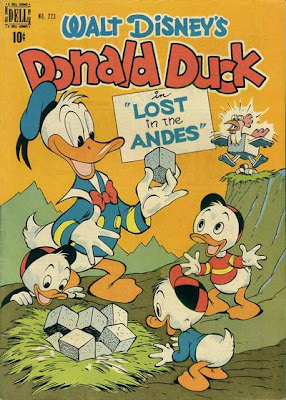With Carl Barks, it's not too much of a stretch to say that he was the first comic book artist to make me distinguish and self-select comics based on who drew them, even though I had not a clue who did it. For the vast majority of Carl Barks' professional life, he was essentially anonymous. He was only known as "the good Duck artist." Until dogged fans finally dragged the information out of Dell/Western in the seventies, Carl Barks had drawn various ducks and other characters since the early forties without so much as a story credit. By his retirement he had written and drawn over 500 stories. Thankfully, in the last decades of his long life (he lived until the ripe old age of 99 and passed away in the year 2000), he was recognized for his brilliance, and his oil paintings reimagining old duck covers and concepts provided a good post-retirement income stream (one painting selling for over $140,000 among two collectors). He created most of the Duckburg universe, including Uncle Scrooge, Magica De Spell, the Beagle Boys, Gladstone Gander, Gyro Gearloose, the money bin, the Junior Woodchucks, and the number one dime.
I distinctly remember, in third grade, having a massive stack of Gold Keys, Harveys and Charltons to look through. Donald Duck, Uncle Scrooge, Richie Rich, Casper, Woodsy Owl, Super Goof, Moby Duck, Popeye, Beetle Bailey, etc. And I was almost hypnotically possessed to drag out the same Uncle Scrooge comics over and over again. To an eight year old kid, Uncle Scrooge, as written and drawn by Carl Barks, was my introduction to world history, archaeology, mythology, geography, and action-adventure. Uncle Scrooge, Donald Duck, and Huey, Dewey and Louie, traveled the globe, from Arabia to Australia to the Yukon to outer space. Those stories were my introduction to comic books, fostered an appreciation and love for them, and remain an influence and inspiration to this day. I continue to attempt to push these books on other unsuspecting readers like crack on a street corner, because they have magical staying power and all-ages appeal. In Europe, Barks continues to be seen as one of the most influential cartoonists in history. In North America, duck collectors continue to spread the word, become Barks completists (easier for the duck books thanks to the Another Rainbow hardcover sets), and analyze and review the multitude of ideas and concepts created by the quiet, humble man from Oregon.
Enjoy these covers, and when given the chance, read the stories inside and share them and others with a kid or two.
















No comments:
Post a Comment